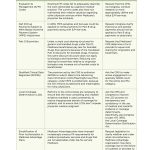(Reuters)—Amid a growing U.S. opioid addiction, health insurer Cigna Corp will stop covering OxyContin, the opioid painkiller sold by Purdue Pharma LP, as of January 1 and will instead cover an equivalent with a formulation less vulnerable to abuse, the company said on Wednesday. The insurer has signed a “value-based contract” with Collegium Pharmaceutical Inc…

MACRA: Tips & Tools for Rheumatology Staff
All healthcare professionals who work in rheumatology had to start adapting to a new landscape of reporting and documentation on Jan. 1 of this year when the Medicare Access and Children’s Health Insurance Program (CHIP) Reauthorization Act, or MACRA, began. As the changeover continues, the Sunday ARHP session, Your New Role in the Era of…

MACRA Has Arrived—& What You Do Now Counts
Changes to reimbursement introduced by the Medicare Access and CHIP Reauthorization Act (MACRA) will affect your Medicare income for 2019. “Rheumatologists generally know that MACRA is up and running,” says Angus Worthing, MD, FACR, FACP, clinical assistant professor of rheumatology at Georgetown University Medical Center and chair of the ACR’s Government Affairs Committee. “Virtually every…
What Price Glory (or, at Least, Getting Your Foot in the Door)?
In many respects, this is the beginning of the golden age of rheumatology. Diagnostic and therapeutic approaches are now available that have radically altered for the better the lives of people with diseases that were considered virtually untreatable just a few years ago. The rheumatologist’s approach to patients with rheumatoid arthritis, the spondyloarthropathies, osteoporosis and…

ACR Pursues Solutions for Flawed MIPS Infusion Regulations & Billing Codes
While the latest version of the Republican-sponsored healthcare bill once again falters and its prospects of becoming the new law of the land fade, plenty of advocacy work is continuing on behalf of rheumatologists and rheumatology practices. The ACR, along with multiple partners, has renewed its push for regulatory relief in a number of areas…
U.S. House Committee Launches Probe of Allergan Patent Deal
NEW YORK (Reuters)—A U.S. House of Representatives committee launched a probe into drugmaker Allergan Plc’s deal to transfer some of its patents to a Native American tribe to shield them from review. A bipartisan group of four representatives from the House Oversight and Government Committee, including Republican Chairman Trey Gowdy and top Democrat Elijah Cummings,…
Obamacare Sign-Up Challenge: Proving the Law Is Not Dead
NOGALES, Arizona (Reuters)—More than two thousand miles away from the healthcare debate in Washington, President Donald Trump’s threats to let Obamacare collapse are sowing confusion about its fate and dampening 2018 enrollment expectations. The uncertainty here in Arizona, echoed in interviews across the country, shows that even though they have not been able to repeal…
Herpes Zoster & Tofacitinib
Shingles, also known as herpes zoster (HZ), is a common and sometimes debilitating disease that disproportionately affects elderly individuals and those who are immunocompromised. Patients with rheumatoid arthritis (RA) have a 1.5–2-fold higher risk of developing HZ compared with healthy adults. Treatment with some disease-modifying anti-rheumatic drugs (DMARDs) has been shown to increase this risk….

Efficacy Studied Following Accelerated Drug Approvals
In recent years, the number of drugs to receive accelerated FDA approval has increased. A new study examined whether these drugs have demonstrated efficacy in post-approval trials…

Adalimumab + Methotrexate Effective for Uveitis in JIA
Research has found that taking adalimumab plus methotrexate is effective for patients with juvenile idiopathic arthritis-associated uveitis. However, these patients may also experience an increased incidence of adverse and serious adverse events compared with those taking only methotrexate…
- « Previous Page
- 1
- …
- 420
- 421
- 422
- 423
- 424
- …
- 842
- Next Page »